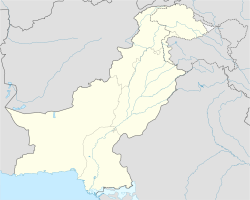Top Qs
Timeline
Chat
Perspective
Hafizabad
City in Punjab, Pakistan From Wikipedia, the free encyclopedia
Remove ads
Hafizabad (Punjabi / Urdu: حافظ آباد; Punjabi pronunciation: [ˈɦäːfᵊ zäbäːd̪]; Urdu pronunciation: [ˈɦɑːfɪzɑbɑːd̪]) is a city and capital of Hafizabad District located in Punjab, Pakistan.[3] Hafizabad is an old settlement. In 327 BC, during Alexander's invasion of Punjab, the territory of the Sandal Bar was reported to be a well populated area. Large cities were located in this territory, and a lot of sub-states were organized under the presidency of maharajas and rajas. It is located to the east of Chenab River.
Remove ads
History
In 327 BC, the area around Hafizabad was reportedly well-populated during Alexander's invasion of Punjab.[4] During the Delhi Sultanate period, majority of the local population converted to Islam. A large city was situated at the site of the present village of Mehdiabad, northwest of present day Hafizabad. Later it became unpopulated due to shortage of water and Afghan incursions. The region remained uninhabited until the reign of Mughal emperor Akbar, when it became the site of a Mahal as documented in Ain-i-Akbari.[5]
After the Partition of India in 1947, the minority Hindus and Sikhs migrated to India while Muslim refugees from India settled in Hafizabad. Most of the refugees have since settled and inter-married with the local population.[citation needed]
Remove ads
Geography
Hafizabad is located 48 kilometres west of Gujranwala, and 60 kilometres southwest of Wazirabad.
Hafizabad railway station located in the city operates four trains to different parts of the country. On the Wazirabad - Faisalabad Railway Section, Hafizabad is the eighth railway station.[6][7][8] Its average elevation is 208 metres above the sea level.[9]
Demographics
Population
According to 2023 census, Hafizabad had a population of 318,621.
Climate
Hafizabad has a humid subtropical climate (Köppen Cwa), bordering on a hot semi-arid climate (BSh). The monsoon season is from June to September. It sees the most precipitation in July, with an average rainfall of 238.1 millimetres or 9.37 inches; and the least precipitation in November, with an average rainfall of 15.5 millimetres or 0.61 inches.
Remove ads
References
Wikiwand - on
Seamless Wikipedia browsing. On steroids.
Remove ads



